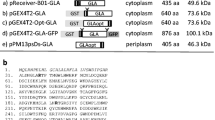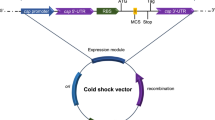Abstract
Recombinant production of mammalian cytoplasmic proteins plays a major role in developing pharmaceutical products. Here we describe two expression technologies using unique nature of halophilic bacteria. One of such properties of halophilic bacteria is accumulation of compatible solutes in the cytoplasm. As the compatible solutes enhance protein solubility and folding, one might utilize these bacteria for cytoplasmic soluble expression of recombinant proteins, as described in this review. Another uniqueness is high reversibility of thermally unfolded halophilic proteins. Here we show that one such protein, β-lactamase (BLA), is highly soluble both in the native and thermally unfolded states and reversibly refolds after thermal melting. This makes BLA as a potential fusion partner for soluble expression of target proteins. The BLA fusion technology is also introduced in the review.





Similar content being viewed by others
Notes
The observed CD change due to unfolding or refolding reflects both its kinetics and the temperature change. As described in the figure legend, the temperature change occurs over the time period of 120 s and hence is too slow to measure the kinetics but too fast to measure equilibrium reaction.
References
Afendra AS, Vargas C, Nieto JJ, Drainas C (2004) Gene transfer and expression of recombinant proteins in moderately halophilic bacteria. Methods Mol Biol 267:209–223
Arakawa T, Timasheff SN (1985) The stabilization of proteins by osmolytes. Biophys J 47:411–414
Arvanitis N, Vergas C, Tegos G, Perysinakis A, Nieto JJ, Ventosa A, Drainas C (1995) Development of a gene reporter system in moderately halophilic bacteria by employing the ice nucleation gene of Pseudomonas syringae. Appl Environ Microbiol 61:3821–3825
Chatterjee DK, Esposito D (2006) Enhanced soluble protein expression using two new fusion tags. Protein Expr Purif 46:122–129
Cline SW, Doolittle WF (1992) Transformation of members of the genus Haloarcula with shuttle vectors based on Halobacterium halobium and Haloferax volcanii plasmid replicons. J Bacteriol 174:1076–1080
Douka E, Christogianni A, Koukkou AI, Afendra AS, Drainas C (2001) Use of a green fluorescent protein gene as a reporter in Zymomonas mobilis and Halomonas elongata. FEMS Microbiol Lett 201:221–227
Dyson MR, Shadbolt SP, Vincent KJ, Perera RL, McCafferty J (2004) Production of soluble mammalian proteins in Escherichia coli: identification of protein features that correlate with successful expression. BMC Biotechnol 4:32
Esposito D, Chatterjee DK (2006) Enhancement of soluble protein expression through the use of fusion tags. Curr Opin Biotechnol 17:353–358
Finn RD, Kapelioukh I, Paine MJ (2005) Rainbow tags: a visual tag systems for recombinant protein expression and purification. Biotechniques 38:387–392
Frillingos S, Linden A, Niehaus F, Vargas C, Nieto JJ, Ventosa A (2000) Cloning and expression of alpha-amylase from the hyperthermophilic archaeon Pyrococcus woesei in the moderately halophilic bacterium Halomonas elongata. J Appl Microbiol 88:495–503
Galinski EA (1995) Osmoadaptation in bacteria. Adv Microb Physiol 37:272–328
Holmes ML, Dyall-Smith ML (1990) A plasmid vector with a selectable marker for halophilic archaebacteria. J Bacteriol 173:756–761
Holmes ML, Nuttall SD, Dyall-Smith ML (1991) Construction and use of halobacterial shuttle vectors and further studies on Haloferax DNA gyrase. J Bacteriol 173:3807–3813
Ignatova Z, Gierasch LM (2007) Effects of osmolytes on protein folding and aggregation in cells. Methods Enzymol 428:355–372
Ishibashi M, Tokunaga H, Hiratsuka K, Yonezawa Y, Tsurumaru H, Arakawa T, Tokunaga M (2001) NaCl-activated nucleoside diphosphate kinase from extremely halophilic archaeon, Halobacterium salinarum, maintains native conformation without salt. FEBS Lett 493:134–138
Ishibashi M, Sakashita K, Tokunaga H, Arakawa T, Tokunaga M (2003) Activation of halophilic nucleoside diphosphate kinase by a non-ionic osmolyte, trimethylamine N-oxide. J Protein Chem 22:345–351
Lam WL, Doolittle WF (1992) Shuttle vectors for the archaebacterium Halobacterium volcanii. Proc Natl Acad Sci USA 86:5478–5482
Marblestone JG, Edavettal SC, Lim Y, Lim P, Zuo X, Butt TR (2006) Comparison of SUMO fusion technology with traditional gene fusion systems: enhanced expression and solubility with SUMO. Protein Sci 15:182–189
Minton AP (2005) Influence of macromolecular crowding upon the stability and state of association of proteins: prediction and observation. J Pharm Sci 94:1668–1675
Mothet JP, Parent AT, Wolosker H, Brady RO Jr, Linden DJ, Ferris CD, Rogawski MA, Snyder SH (2000) d-serine is an endogenous ligand for the glycine site of the N-methyl-d-aspartate receptor. Proc Natl Acad Sci USA 97:4926–4931
Nagayoshi C, Ishibashi M, Kita Y, Matsuoka M, Nishimoto I, Tokunaga M (2005) Expression, refolding and characterization of human brain serine racemase in Escherichia coli with N-terminal His-tag. Protein Pept Lett 12:487–490
Nagayoshi C, Tokunaga H, Hayashi A, Harazono H, Hamasaki K, Ando A, Tokunaga M (2006) Efficient expression of haloarchaeal nucleoside diphosphate kinase via strong porin promoter in moderately halophilic bacteria. Protein Pept Lett 13:611–615
Nagayoshi C, Ishibashi M, Tokunaga M (2009) Purification and characterization of human brain serine racemase expressed in moderately halophilic bacteria. Protein Pept Lett 16:201–206
Ni BF, Chang M, Duschl A, Lanyi J, Needleman R (1990) An efficient system for the synthesis of bacteriorhodopsin in Halobacterium halobium. Gene 90:169–172
Nomura S, Harada Y (1998) Functional expression of green fluorescent protein derivatives in Halobacterium salinarum. FEMS Microbiol Lett 167:287–293
Oren A, Larimer F, Richardson P, Lapidus A, Csonka LN (2005) How to be moderately halophilic with broad salt tolerance: clues from the genome of Chromohalobacter salexigens. Extremophiles 9:275–279
Patenge N, Haase A, Bolhuis H, Oesterhelt D (2000) The gene for a halophilic beta-galactosidase (bgaH) of Haloferax alicantei as a reporter gene for promoter analyses in Halobacterium salinarum. Mol Microbiol 36:105–113
Qu Y, Bolen CL, Bolen DW (1998) Osmolyte-driven contraction of a random coil protein. Proc Natl Acad Sci USA 95:9628–9273
Kennedy SP, Ng WP, Salzberg SL, Hood L, DasSarma S (2001) Understanding the adaptation of Halobacterium species NRC-1 to its extreme environment through computational analysis of its genome sequence. Genome Res 11:1641–1650
Söhlemann P, Soppa J, Oesterhelt D, Lohse MJ (1997) Expression of beta 2-adrenoceptors in halobacteria. Naunyn-Schmiedebergs Arch Pharmacol 355:150–160
Terpe K (2003) Overview of tag protein fusions: from molecular and biochemical fundamentals to commercial systems. Appl Microbiol Biotechnol 60:523–533
Tokunaga H, Ishibashi M, Arakawa T, Tokunaga M (2004) Highly efficient renaturation of beta-lactamase isolated from moderately halophilic bacteria. FEBS Lett 558:7–12
Tokunaga H, Arakawa T, Fukada H, Tokunaga M (2006) Opposing effects of NaCl on reversibility and thermal stability of halophilic beta-lactamase from a moderate halophile, Chromohalobacter sp. 560. Biophys Chem 119:316–320
Tokunaga H, Arakawa T, Tokunaga M (2008) Engineering of halophilic enzymes: two acidic amino acid residues at the carboxy-terminal region confer halophilic characteristics to Halomonas and Pseudomonas nucleoside diphosphate kinases. Protein Sci 17:1603–1610
Tokunaga H, Saito S, Sakai K, Yamaguchi R, Katsuyama I, Arakawa T, Onozaki K, Arakawa T, Tokunaga M (2010) Halophilic β-lactamase as a new solubility- and folding-enhancing tag protein: production of native human interleukin 1α and human neutrophil α-defensin. Appl Microbiol Biotechnol 86:649–658
Vargas C, Nieto JJ (2004) Genetic tools for the manipulation of moderately halophilic bacteria of the family Halomonadaceae. Methods Mol Biol 267:183–208
Vargas C, Fernández-Castillo R, Cánovas D (1995) Isolation of cryptic plasmids from moderately halophilic eubacteria of the genus Halomonas. Characterization of a small plasmid from H. elongata and its use for shuttle vector construction. Mol Gen Genet 246:411–418
Ventosa A, Nieto JJ, Oren A (1998) Biology of moderately halophilic aerobic bacteria. Microbiol Mol Biol Rev 62:504–544
Waugh DS (2005) Making the most of affinity tags. Treds Biotechnol 23:316–320
Widmann M, Christen P (2000) Comparison of folding rates of homologous prokaryotic and eukaryotic proteins. J Biol Chem 275:18619–18622
Wilkinson DL, Harrison RG (1991) Predicting the solubility of recombinant proteins in Escherichia coli. Bio/Technology 9:443–448
Wolosker H (2007) NMDA receptor regulation by d-serine: new findings and perspectives. Mol Neurobiol 36:152–164
Yonezawa Y, Izutsu K, Tokunaga H, Maeda H, Arakawa T, Tokunaga M (2007) Dimeric structure of nucleoside diphosphate kinase from moderately halophilic bacterium: contrast to the tetrameric Pseudomonas counterpart. FEMS Microbiol Lett 268:52–58
Author information
Authors and Affiliations
Corresponding author
Rights and permissions
About this article
Cite this article
Tokunaga, H., Arakawa, T. & Tokunaga, M. Novel soluble expression technologies derived from unique properties of halophilic proteins. Appl Microbiol Biotechnol 88, 1223–1231 (2010). https://doi.org/10.1007/s00253-010-2832-8
Received:
Revised:
Accepted:
Published:
Issue Date:
DOI: https://doi.org/10.1007/s00253-010-2832-8




